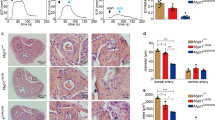Abstract
Penile erection is a vascular phenomenon that results from smooth muscle relaxation, arterial dilation and venous restriction. The atherosclerosis of the penis that occurs with aging causes a decrease in penile oxygen tension. A reduction of smooth muscle cells has been demonstrated in relation with this change in oxygen tension. Changes in the ratio of penile collagen have also been observed and could explain the decrease in penile elasticity and compliance. Chronic ischemia is, therefore, associated with fibrosis but also with nitric oxide (NO)-cyclic guanosine monophosphate. The sensitivity of the α-adrenoceptors on the smooth muscle cells increases with aging. All those modifications can explain the prevalence of erectile dysfunction with aging. Low oxygen tension in prostanoid production may also play a role in the mechanism of ischemia-induced cavernosal fibrosis; however, intracavernous injections of prostaglandin E1 do not seem to modify the intracavernous structures by reducing muscular atrophy. The effects of androgen on libido and sexual behavior are well established, but their role in the human erectile mechanism remains unclear. Several studies performed on animals have demonstrated impacts directly on both the physiological function and the trabecular structure of the corpora cavernosa in rats, dogs and rabbits. However, in humans, no study seems to demonstrate a role of testosterone on muscular atrophy or penile neurologic control. Testosterone treatment alters the human behavior but not penile physiologic processes. Further studies are necessary to explain the real role of testosterone not only on the peripheral mechanism of erection but also on the central control.
This is a preview of subscription content, access via your institution
Access options
Subscribe to this journal
Receive 8 print issues and online access
$259.00 per year
only $32.38 per issue
Buy this article
- Purchase on Springer Link
- Instant access to full article PDF
Prices may be subject to local taxes which are calculated during checkout
Similar content being viewed by others
Author information
Authors and Affiliations
Corresponding author
Rights and permissions
About this article
Cite this article
Wespes, E. Smooth muscle pathology and erectile dysfunction. Int J Impot Res 14 (Suppl 1), S17–S21 (2002). https://doi.org/10.1038/sj.ijir.3900792
Published:
Issue Date:
DOI: https://doi.org/10.1038/sj.ijir.3900792
Keywords
This article is cited by
-
Exosomes derived from miR-301a-3p-overexpressing adipose-derived mesenchymal stem cells reverse hypoxia-induced erectile dysfunction in rat models
Stem Cell Research & Therapy (2021)
-
Phase I and registry study of autologous bone marrow concentrate evaluated in PDE5 inhibitor refractory erectile dysfunction
Journal of Translational Medicine (2020)
-
Sonography of the penis/erectile dysfunction
Abdominal Radiology (2020)
-
The Relationship between Systemic Hypertension and Erectile Dysfunction
Current Sexual Health Reports (2015)
-
Androgen depletion in humans leads to cavernous tissue reorganization and upregulation of Sirt1–eNOS axis
AGE (2013)



